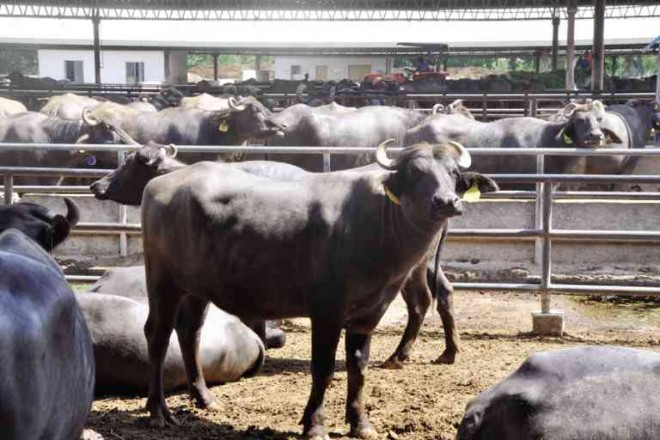
THE PHILIPPINE Carabao Center in the Science City of Muñoz in Nueva Ecija keeps a herd of dairy carabaos to maintain a gene pool and help preserve the country’s carabao population. WILLIE LOMIBAO
KILOMETERS 143 and 151 along the Maharlika Highway in the Science City of Muñoz are important markers for visitors on an educational trip to Nueva Ecija.
On whichever point they alight, those joining any “lakbay-aral” (educational trip) will learn new things from the member-agencies of the science community here.
This section of Muñoz was declared a “science community” by the Department of Science and Technology in 1993. In 2001, it was proclaimed as the “agrotourism site for Luzon” by the Department of Tourism and the Department of Agriculture, in coordination with the University of the Philippines’ Asian Institute of Tourism.
Although the place is without beaches, a major attraction for most tourists, visitors have said the five-hour tour here is worth the trip.
Among the institutions and agencies commonly visited are the Central Luzon State University (CLSU), Philippine Rice Research Institute (PhilRice), Philippine Carabao Center (PCC), Philippine Center for Postharvest and Mechanization (PhilMech), and the Tilapia Science Center and the Regional Crop Protection Center.
Also in the itinerary are the Philippine-Sino Center for Agricultural Technology, Philippine–Israel Center for Agricultural Training, the office of the Casecnan Multipurpose Irrigation and Power Project, two district offices of the Upper Pampanga River Integrated Irrigation Systems, the provincial office of the Department of Science and Technology, and the South Nueva Ecija office of the Department of Environment and Natural Resources.
‘Science city’
The City Hall is also a place of interest as visitors are briefed about how the only science city in the country operates. Muñoz was officially declared a “science city” in 2000.
“Our community here boasts of having centers of excellence in science and technology. That’s why visitors come, particularly those seeking more knowledge in these fields,” said Mayor Nestor Alvarez.
Most visited
The CLSU campus, which was set up as the government’s agricultural school in 1907, has become a “must-see” in the city.
The university has an office that guides tourists on places to visit in the 658–hectare campus.
Among the important spot for agritours at the CLSU campus are:
Agricultural Museum showcases rice and vegetable planting implements, household/indigenous utensils, personal apparel and hunting and fishing implements. They are meant to promote the cultural heritage of Filipinos, particularly those in Central Luzon, in agriculture.
Biodiversity Museum features terrestrial, freshwater, agroecosytem and forest ecosystem exhibits. It has vast collections of insects, preserved specimens of macrofungi, invertebrates, lichens and others, earth
resources and an “earth watch” nook.
Living Fish Museum houses indigenous and tropical freshwater fish collected from different provinces in Luzon. It has collections of indigenous fish, ornamental freshwater fish, reptiles, mollusks and aquatic plants.
Concrete Tank Culture of Tilapia demonstrates intensive culture of tilapia in concrete circular tanks, with provisions for continuous water exchange and aeration. Each tank is stocked with 6,000 tilapia fingerlings.
CLSU Ramon Magsaysay Center for Agricultural Resources and Environment Studies Training Center promotes organic farming culture and has services for waste assessment and ecological and solid waste planning, land crop suitability training on organic rice and vegetable production, training on organic inputs, and training on trichoderma production and utilization.
Small Ruminant Center is the lead agency in small ruminant research, development and extension under the DA-Bureau of Agricultural Research. It develops and promotes the goat and sheep industry in Luzon.
Science and Technology Centrum is a one-stop information shop on research
development breakthroughs and technologies generated and promoted by CLSU. It features exhibit displays of models and live specimens organized into crop, aquaculture, agritechnology, environment and development galleries.
Also of interest to visitors are the mushroom center and the showcase of hydroponics, which also features urban and vertical gardening using soil-less culture.
‘Beast of fortune’
About a kilometer north of the CLSU main gate is the PCC national headquarters and gene pool. On its 20-ha compound are dairy carabaos used for breeding and dairying purposes, its biotech laboratories, and showcases of carabao-based enterprises.
The improved breed of carabaos has become the new wave for changing the lives of farmers and improving rural communities. It is a source of draft animal power, meat, milk and hide.
Also a major agency hosted by Muñoz is PhilRice, which develops high-yielding and cost-reducing technologies for rice production. It implements a natural rice research and development program, sustains the gains made in rice production and solves location-specific problems of the rice industry.
After the tour, visitors can rest at the Rizal Park, in which national hero, Dr. Jose Rizal, is depicted as wearing a “barong Tagalog.” They may take lunch at the Lingap-Kalikasan Park and stroll along the tree-lined roads on campus.